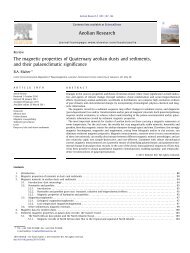Mono- and dicyclic unsaturated triterpenoid hydrocarbons in ...
Mono- and dicyclic unsaturated triterpenoid hydrocarbons in ...
Mono- and dicyclic unsaturated triterpenoid hydrocarbons in ...
You also want an ePaper? Increase the reach of your titles
YUMPU automatically turns print PDFs into web optimized ePapers that Google loves.
888 R. de Mesmay et al. / Organic Geochemistry 39 (2008) 879–893<br />
the present case of b, the molecular ion at m/z 470 is consistent<br />
with a tetrahydrobotryococcene (C34H62). Fragment<br />
ions at m/z 123, 177 <strong>and</strong> 231 suggest the presence of a<br />
trimethylated cyclohexenyl r<strong>in</strong>g <strong>in</strong> the left half part of the<br />
molecule. In addition, a diagnostic ion at m/z 259 result<strong>in</strong>g<br />
from the cleavage of the C-12/C-13 bond <strong>in</strong>dicated that<br />
two additional unsaturations were present at C-11 <strong>and</strong><br />
C-26. The ozonides O11 <strong>and</strong> more especially O1, although<br />
not specific for the degradation of b (Table 1), also support<br />
structure b as an unprecedented tetrahydrogenated<br />
derivative of k (David et al., 1988), with the C-17/C-29<br />
<strong>and</strong> C-21/C-22 double bonds be<strong>in</strong>g hydrogenated.<br />
3.1.5. C36 <strong>and</strong> C37 monocyclic botryococcenes <strong>and</strong> partially<br />
reduced counterparts<br />
GC-MS analysis of the hydrogenated hydrocarbon fraction<br />
revealed, <strong>in</strong> addition to the aforementioned botryococcanes,<br />
the presence of two C 36 (H4) <strong>and</strong> two C 37 (H6)<br />
monocyclic botryococcanes (Fig. 3A). Each of these two couples<br />
exhibited strictly identical mass spectra, with diagnostic<br />
ions <strong>in</strong>dicative of the presence of a r<strong>in</strong>g <strong>in</strong> the left part of<br />
the molecule (ions at m/z 236/237, Fig. 3D <strong>and</strong> F). The mass<br />
spectra of H4 <strong>and</strong> H6 show similarities to that of H2. Two<br />
(respectively three) additional carbons are situated on the<br />
right h<strong>and</strong> moiety of the molecules (ions at m/z 322/323<br />
for H4, Fig. 3D <strong>and</strong> at m/z 336/337 for H6, Fig. 3F).<br />
C36 botryococcanes H4 probably result from the catalytic<br />
hydrogenation of two partially coelut<strong>in</strong>g C 36 botryococcenes<br />
(M +. at m/z 494, f1 <strong>and</strong> f2) with identical mass spectra<br />
(Figs. 2A <strong>and</strong> 7C) <strong>and</strong> two dihydrogenated counterparts (g1<br />
<strong>and</strong> g2), also partially coelut<strong>in</strong>g (Fig. 2A) with identical<br />
spectra (M +. at m/z 496; Fig. 7C). Fragments at m/z 123,<br />
177, 231 <strong>and</strong> 285 <strong>in</strong> f1, f2, g1 <strong>and</strong> g2 confirmed the occurrence<br />
of a trimethyl cyclohexenyl r<strong>in</strong>g <strong>in</strong> the left h<strong>and</strong> moeity<br />
<strong>and</strong> of two unsaturations at C-11 <strong>and</strong> C-26. The<br />
structures of the right h<strong>and</strong> parts of the compounds were<br />
deduced from the identification <strong>in</strong> the ozonolysis products<br />
of the di- <strong>and</strong> tri-oxygenated compounds O4 <strong>and</strong> O6, respectively<br />
(Table 1). The McLafferty fragment at m/z 86 <strong>in</strong> their<br />
spectra (e.g. Fig. 6B for O4) suggests the presence <strong>in</strong> the<br />
structure of an ethyl ketone exhibit<strong>in</strong>g a methyl group <strong>in</strong><br />
the a position. Consequently, an ethyl group would be present<br />
at ‘‘C-21” (numbered accord<strong>in</strong>g to botryococcene structures)<br />
<strong>in</strong> f1, f2, g1 <strong>and</strong> g2. Moreover, the molecular formulae<br />
of O4 <strong>and</strong> O6 (C16H30O2 <strong>and</strong> C16H26O3, respectively) established<br />
that a C2 moiety was lost from the right h<strong>and</strong> part<br />
dur<strong>in</strong>g ozonolysis, suggest<strong>in</strong>g the presence of a CH3CH=C<br />
pattern <strong>in</strong> the C36 botryococcenes f1 <strong>and</strong> f2, <strong>and</strong> the dihydro<br />
derivatives g1 <strong>and</strong> g2. F<strong>in</strong>ally, the McLafferty fragment at m/<br />
z 170 <strong>in</strong> the spectrum of O6 <strong>in</strong>dicates the presence of a ketone<br />
at ‘‘C-17” (data not shown), <strong>and</strong> the two discrete ions<br />
at m/z 113 <strong>and</strong> 141 <strong>in</strong> the spectrum of O4 show the presence<br />
of a methyl at ‘‘C-17” (Fig. 6B).<br />
These results allow us to tentatively assign f1 <strong>and</strong> f2 as<br />
monocylic C 36 botryococcenes <strong>and</strong> g1 <strong>and</strong> g2 as their dihydro<br />
derivatives. The occurrence of two pairs of isomers with<br />
identical mass spectra is probably due to the existence of<br />
stereoisomers with respect to the C-21/C-22 double bond<br />
stereochemistry. Based on semi-empirical topological<br />
methods for the prediction of the chromatographic retention<br />
of alkene isomers (He<strong>in</strong>zen et al., 1999; Junkes et al.,<br />
2002), it can be assumed that the stereochemistry of the<br />
C-21 double bond is E <strong>in</strong> f1 <strong>and</strong> g1 <strong>and</strong> Z <strong>in</strong> f2 <strong>and</strong> g2.<br />
Similarly, botryococcanes H6 were probably produced by<br />
the catalytic hydrogenation of C37 botryococcenes (C37H64,<br />
M +. at m/z 508) <strong>and</strong> dihydro counterparts (C 37H 66, M +. at<br />
m/z 510) (Table 1 <strong>and</strong> Fig. 3). Among the ozonolysis products,<br />
only the di- <strong>and</strong> tri-oxygenated O5 <strong>and</strong> O7, respectively<br />
(Table 1) could be related to C37 hydrocarbon<br />
precursors. MS comparisons showed that O5 (C 17H 32O 2)<br />
<strong>and</strong> O7 (C17H28O3) were higher homologues of O4 <strong>and</strong> O6,<br />
respectively. Moreover, a base peak at m/z 43 <strong>in</strong> the spectrum<br />
of O7 (Fig. 6D) suggested that the carbon skeleton<br />
probably has a term<strong>in</strong>al isopropyl group. The occurrence<br />
of an isopropyl group <strong>in</strong> O5, justas<strong>in</strong>h <strong>and</strong> i, was also supported<br />
by the presence <strong>in</strong> the spectra of significant ions at<br />
m/z [(M-43) + ; Figs. 6C <strong>and</strong> 7D, E]. The presence of a<br />
CH3CH=C pattern at C-21 <strong>in</strong> h <strong>and</strong> i is supported by the presence<br />
of a ketone a to the isopropyl group both <strong>in</strong> O5 <strong>and</strong> O7<br />
<strong>and</strong> by biogenetic considerations (see below). The comb<strong>in</strong>ation<br />
of O7 with O9,allowsustoproposeh as a higher homologue<br />
of f1 <strong>and</strong> f2 with one more carbon. The spectra of O5<br />
<strong>and</strong> O7 exhibit some identical fragments (m/z 100, 113, 155,<br />
225, 240), but an ion at m/z 184 <strong>in</strong> that of O7, due to McLafferty<br />
rearrangement, <strong>and</strong> two discrete ions at m/z 113 <strong>and</strong><br />
155 <strong>in</strong> that of O5, <strong>in</strong>dicate that O5 <strong>and</strong> O7 differ by way<br />
of the presence of a methyl group <strong>and</strong> a ketone, respectively.<br />
These data suggest that i <strong>and</strong> h only differ <strong>in</strong> the presence<br />
of an exomethylene <strong>and</strong> a methyl group at C-17,<br />
respectively. In contrast to the C36 homologues, h (respectively<br />
i) does not appear as a mixture of two compounds<br />
<strong>in</strong> the GC chromatogram. Nevertheless, h (respectively i)<br />
may occur as a mixture of stereoisomers that are not separated<br />
under the GC conditions used.<br />
3.2. Occurrence of masokocenes <strong>in</strong> ancient ecosystems<br />
Dicyclobotryococcenes have been recently reported to<br />
occur <strong>in</strong> sediments of a Norwegian fjord (Smittenberg<br />
et al., 2005) <strong>and</strong> <strong>in</strong> freshwater wetl<strong>and</strong>s of the Florida Everglades<br />
(Gao et al., 2007), but their structures were not<br />
unambiguously determ<strong>in</strong>ed. On the other h<strong>and</strong>, a hypothetical<br />
dicyclobotryococcene exhibit<strong>in</strong>g a planar structure<br />
similar to that of c had already been assumed to be the precursor<br />
of a major dicyclobotryococcane (tentatively assigned<br />
as H3) detected after Raney nickel desulfurisation<br />
of a polar lipid fraction from Miocene/Pliocene immature<br />
hypersal<strong>in</strong>e sediments (Sdom Formation near the Dead<br />
Sea; Grice et al., 1998). The authors supposed that c was<br />
<strong>in</strong>corporated <strong>in</strong>to a macromolecular matrix via sulfurisation.<br />
The lack of c among the extractable biomarkers of<br />
the Sdom formation was expla<strong>in</strong>ed by its ease of sulfurisation<br />
due to the presence of four double bonds. The strong<br />
dom<strong>in</strong>ance of <strong>in</strong>tact masokocene c <strong>in</strong> a ca. 32,000 year<br />
old sediment <strong>in</strong>dicates excellent conditions of preservation<br />
<strong>in</strong> Lake Masoko sediments, even though the compound<br />
might be sensitive to sulfurisation as well as to oxidative<br />
or reductive attack. Although B. braunii race B is known<br />
to produce large amounts of <strong>hydrocarbons</strong>, the lack of a<br />
hydrocarbon biomarker from other sources <strong>in</strong> Lake Masoko<br />
ca. 32000 years ago is a clue for an ecosystem dom<strong>in</strong>ated at<br />
the time by blooms of B. braunii. This situation strongly








